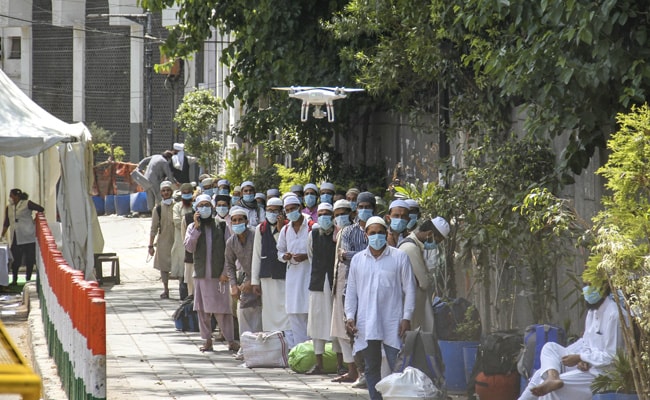
RELIGION UNITES: IT’S TIME TO GET BACK TOGETHER By ANAND SAXENA
CoVid 19 spread continues unabated despite humongous efforts to fight it by the governments across the world duly supported by populations who are suffering untold hardships yet showing great resilience and positivity. “This too shall pass”- and it is not a cliched statement but my firm belief, for, the humankind has been through worse, and yet survived. There are endless debates as to where and how the virus originated but the method of the spread of the virus is beyond debate. It happened by human- to- human transmission. It happened across the continents and countries. It did not differentiate between black or white, poor or rich, men or women and so on. It has turned out a most egalitarian virus, which has given a clarion call to the world about its inherent vulnerabilities due to existing interdependencies. A disturbing trend seems to be emerging though, that these interdependencies must be broken and the new post- CoVid 19 world should be more insular, more selfish, where each country looks after its own interests.
Alongside, fissures also seem to be getting exacerbated along existing fault lines- religion, social, caste etc. So far as India is concerned, we have witnessed the indiscretion of Tablighi Jamaat, in holding their Nizamuddin event despite instructions to the contrary. This event has resulted in the exponential spread of CoVid positive cases. As per the government statistics, 30% of the total CoVid positive cases in India are caused by this momentous Tablighi event (TOI, 19 Apr 20 refers.) This has resulted in some vicious social media posts where the entire Muslim community is being targeted, resulting in uncivil back and forth social media exchanges. Simultaneously, there are Hindu luminaries like the ex- CM of Karnataka, who marries off his son on 17 Apr 20, with all the pomp and show, caring little about social- distancing norms. He, however, has not yet been targeted for his indiscretion, for being a Hindu. Well, I did not see this kind of vicious backlash against the Hindu community after the ghastly Nirbhaya incident of 2012, where all the six perpetrators were Hindu. Clearly, the society including the educated middle class is being divided along the fault lines of existing fissures.

These mala fide social media posts have suddenly spiked up post Nizammudin event and are rather professionally and slickly made. In these posts, the facts (around 10% or so) are ingeniously mixed with fiction (around 90%) to paint one community in negative and anti-national light. The educated middle class must ponder over the origin of these poisonous posts- who is creating these? Knowing the cyber and propaganda capabilities of our adversaries, China and Pakistan, it is not very difficult to guess the start point. Sadly, we keep forwarding these posts and, on the way, add our own prejudices in the form of further comments like, “I told you so”, “These people can’t be trusted” etc. Really? Have we forgotten the luminaries like President APJ Abdul Kalam, Havildar Abdul Hamid, Param Vir Chakra of 1965 war, Dilip Kumar, Azim Premji, Muhammad Rafi, Sania Mirza, MAK Pataudi- I can easily add thousands of Muslim names who brought immense pride to their beloved motherland?
This small article has been borne out of my anguish at seeing these disturbing developments where we seem to be drifting apart and isolating ourselves. The need of the hour is to stand together and fight this dreaded virus. We all are one and all the divisions and schisms have been self- created by mankind. Since the issue of religion is causing the greatest consternation in India, this article addresses this issue head-on.
Stone Age
Modern humans are estimated to be at least 2 Lakh years old, having originated in Africa, same time as the Neanderthal men in Europe and West Asia. Approximately 70,000 years back, a handful of these humans braved a long and arduous journey across red sea to reach Southern Arabian Peninsula, where they remained for thousands of years, procreating in the salubrious climate. All the differences among us that we may talk about are indeed superficial and all of us humans are made of the same genetic pool- we all are Africans. Our ancestors then walked along the Persian Gulf coast, stayed and populated there, before setting a course towards Indian Subcontinent. Indigenous tribes of Andaman and Nicobar are probably the last remnants of this early migration. India, as we know it today, was probably populated by humans approximately 50-60,000 years ago.
Ice Age
Around 24,000 years ago the Ice age is supposed to have started. The ice started to melt nearly 14,000 years ago, causing a rise in the sea levels. This caused the Great Flood which finds mention in the Sumerian, Biblical and Hindu texts as also in Holy Quran (Sumerians were part of ancient Mesopotamia-land between Tigris and Euphrates river systems consisting of modern-day Iraq, Syria and Kuwait including region between Turkey-Syria and Iran-Iraq border). In fact, the similarity in all these accounts, cutting across religious texts is mindboggling. In Matsya Purana, Lord Vishnu takes his first incarnation, out of a total of 10, as a giant fish. This Fish instructs Manu to construct a big ship on which Sapta Rishis (the seven sages) with their families, a male and female of all animal species, and seeds of all plant varieties will be carried. This was done in anticipation of a great flood in which all living things on earth will perish. Lord Vishnu, in his Matsya Avtar, then pulled this ship with all occupants to safety despite raging flood and thus saved humanity for another day. This story pertains to the end of Satya Yug, the first Yug out of the four-Satya, Treta, Dwapar and Kaliyug.
Story of Noah’s Ark is mentioned in the Torah (means teaching) in Genesis flood narrative, in turn, part of the Old Testament. In this story, God spares Noah, his family and remnants of all the worlds’ animals who could travel in the ark. Striking similarities are found in the duration of Vedic and Genesis floods, both lasting 40 days. Also, in both Matsya Purana and Torah, God gives a notice period of one week to both Manu and Noah, before the deluge strikes. The narrative of Noah finds mention in holy Quran as well where Noah is mentioned as NUH, one of the Prophets. It is no coincidence that a similar story of great flood and saving of mankind by God runs across various religions. The story is meant to educate and illuminate human minds, no matter which religion they follow.
We move further to Indian civilization- How old is the Indian civilization? The Harappan or Indus Valley civilization puts us roughly between 3500 and 2000 BC, the decline of Late Harappan occurring around 1400 BC. At its peak, it covered the area of North-West Afghanistan, Pakistan and North-West India and was bigger than Egyptian, Chinese and Mesopotamian civilizations. As we know, it was situated on the banks of the Indus and Ghaggar-Hakra rivers. The maximum concentration of Indus Valley civilization was in the Thar Desert which appears surprising today, but dates back to the time when this area was green and fertile, fed by Ghaggar-Hakra River system. In fact, the lack of water is what caused this civilization to wither away. I am covering this issue here to drive home the point that whatever be our religion today our civilization and cultural root are same and go back a very long way. Being part of such an old and advanced civilization also teaches us to be civil and be able to settle our differences by talks and not violence.
Vedas

Let us now start looking at religion. The point I wish to make is that all major religions of the world have either originated in India or have a major presence here, demonstrating our secular and liberal nature where all are free to follow their own culture and religion. We start with Vedas, considered to be the oldest extant book in the world and the heart of Hinduism. If one considers Vedas to be the exclusive preserve of Hindus, it cannot be farther from the truth. Partly we have already covered this issue in the tales of Noah and Manu. As we know there are four Vedas-Rig, Sama, Yajur and Atharva, Rig Veda being the oldest from which comes the Gayatri Mantra. Rig Veda is estimated to be between 4000 to 1000 BC, more likely closer to 2000 BC. Notice that the period coincides with the Indus Valley civilization period. Rig Veda talks of a region of Sapta Sindhu or seven rivers. These are Indus, five rivers of Punjab and Saraswati, the mysterious extinct river, which some consider being same as Ghaggar-Hakra of Indus Valley civilization. So, the geographical spread of Indus valley civilization and what is mentioned in Vedas do match.
The Sanskrit of Rig Veda is very similar to the language used in Avesta, the oldest and most sacred text of Zoroastrian religion which we know was an Indo-Iranian religion formed by Prophet Zoroaster somewhere in 1200 to 1500 BC. Incidentally, maximum followers of this religion stay in India as Parsis, who were persecuted out of Iran in the 8th century AD for their religious beliefs. They found a safe sanctuary in India where until today they are free to follow their religious beliefs. Then there are people called YEZIDIS, just about 1,50,000 or so in the world and occupying areas of Northern Iraq and Eastern Turkey, who were in the news for their persecution by ISIS. Yezidis follow traditions which are a mix of Islam, Christian and Zoroastrian religions. Notice the similarity in language and culture of people apparently so different from each other.
We now turn to next major religion, Judaism, which also has linkages with India, the state of J and K. We know about Exodus when Moses or Musa led the Israelites out of Egypt which in turn led to the revelations at Mount Sinai including the Ten Commandments. The wanderings for the promised land of milk and honey led them further to Mount Nebo, which is in Current Jordan, where Moses climbed the hill to look at the Promised Land. He died there and is supposed to have been buried there; however, the place of burial of Moses is not found till date. In the book Jesus lived in India, the author Holger Kersten claims that the actual Mount Nebo is in Kashmir, 12 Km from Bandipur, at a place called Hazbal where Muqam-e-Musa is found, which the author claims is the tomb of Moses- Muqam is destination, so final destination or resting place of Musa. Also, we know that Kashmir is sometimes referred to as Bagh-e-Suleiman and there is Takht-e-Suleiman or Throne of Solomon on Shankaracharya hill, suggesting visit by King Solomon, son of David, to Kashmir. Since we know the time duration of the reign of King Solomon, which is 960 to 931 BC, the chronology falls into place.
Having looked at these major religions and their linkages to India we now move on to the era of Chandra Gupta Maurya, born in 340 BC. Around 300 BC, he ruled an area from the edge of Eastern Iran to Bangladesh except for a part of Southern India. As an empire, it was bigger than even Alexander`s. His period is also famous for the ultimate strategist Chanakya and his Arthashastra, which is referred worldwide on the matters of stratagem. In 297 BC, Chandra Gupta Maurya gave up all worldly possessions, handed over his kingdom to his son Bindusar and converted to Jainism. Jain dharma, as we know dates back to 6th century BC and as a religion was founded by 24th Tirthankar, Mahavir in Eastern India. So, we see the power of religion here, the most powerful emperor in this part of the world, giving it up all to follow a path of salvation through a different religion. We see real tolerance here.
As we trace the Maurya dynasty further we reach the next major religion, Buddhism, founded by Gautama Buddha in the 6th century BC (563 BC) at Bodh Gaya, Bihar, so essentially another Indian religion. Emperor Ashoka, who was the son of Bindusar converted to Buddhism in around 260 BC. Ashoka was an even greater king than his grandfather, Chandra Gupta who extended his kingdom further and his rule extended to Kashmir also. He conquered Kalinga (modern Odisha) which resulted in nearly 2 Lakh deaths and widespread destruction. This made Ashoka walk the path of penance and convert to Buddhism. The power of religion and link of all major religions to India is again highlighted here. What also comes out clearly is that religion is one’s personal matter and each human being should be free to walk this path for his/her salvation.
We now move on to another religion which apparently has no major connection with India, Christianity. However, I have already mentioned this book called Jesus lived in India by Holger Kersten which throws a different light on the connection of even Christianity to India. This, in turn, is based on accounts of a Russian historian, Nikolai Notovitch who visited HEMIS monastery at Leh in 1887 and was told about one Christian Dalai Lama called Issa who stayed there and was none other than Jesus himself. He cites the manuscripts, written in ancient Indian language Pali, which were given to him for reading by the monks of the monastery. I then read Dr Fida Hasnain, noted historian of Kashmir, who also supports this theory in his book Jesus in Kashmir. It is also mentioned in Nath Namavali, an old Indian Sutra, which mentions a saint Isha Nath, who arrived in India at the age of 14 years, learnt what India had to offer and went back to his native place. There he fell victim of a conspiracy and was crucified. However, by Yogic powers that he had learnt in India, he survived execution, returned to India where he founded an Ashram monastery in the foothills of Himalayas. We know that Jesus Christ is called Issa Masih- Masiha is a prophet. The author goes on to say that Rozabal shrine in downtown Srinagar, has a grave of Saint Yus Asaf, who was none other than Jesus himself who survived the crucifixion and came to Srinagar. This is also mentioned in a book called Ikmalludin, written by Iranian historian Al-Said-Us-Sadiq in AD 862. It is also a fact that exact account of the life of Jesus is not available between the ages of about 12 to 28 years. I am not here to debate the authenticity of these claims; however, the strong bonds of both Judaism and Christianity to India become abundantly clear. It also points to the syncretism that is steeped in the culture of India.

We shift our gaze to Islam, founded by Prophet Mohammed in seventh century AD in Arabia, Mecca and Medina, a religion so powerful that within a century of its advent it spread across Arabian Peninsula to the Middle East and North Africa. At one time, it was followed as far wide as Spain in the West and India and China in the East. Today it constitutes the world`s second-largest religion, with approximately 1.7 Billion followers which amount to roughly 22% of the world`s population. The similarities between Islam and Christianity/Judaism are many and I would not like to cover them here. But one important thing I wish to highlight is that Mohammed is considered as the last prophet in the series of Adam, Noah, Abraham, Moses and Jesus among others. It is also believed that his messages complete the revelations that started with earlier prophets. Anyway, coming to our country, sometimes we get misled by thinking that Muslims are a minority here, but remember the numbers we are talking about. In India resides approximately 11% of the world Muslim population, second only to Indonesia and which is as large as the total population of Pakistan.
Few would know that the second mosque in the world was constructed in India, in the state of Kerala at Kodungallur, way back in AD 629. The first mosque was incidentally, at Medina, where the Prophet founded the religion of Islam. AD 629 was the year when even Mecca was not conquered and converted to Islam by Prophet Muhammad. There is this fascinating story of the king, Cheraman Perumal, who travelled to Arabia, met Prophet Muhammad and got converted to Islam. He was asked to spread the religion of Islam in India by Muhammad. On his way back, however, Cheraman fell ill and died in Oman. He, however, instructed his fellow travellers to go to his kingdom and introduce the religion of Islam. He gave a letter to this effect to his fellow travellers and the letter was honoured by his sons. The place which was given to establish the first mosque was incidentally an abandoned Buddhist Math. We see that so many centuries back also, India had the resilience and maturity to handle an alien religion. Why and how have we lost it over a period of time is for all of us to ask and answer?
And now on to the next most dominant religion of our country, Sikhism, a proud race known for their valour. Formalized as a religion by Guru Nanak in the fifteenth century, it has approximately 30 million followers worldwide, 90% of whom reside in India. A presumably Muslim dominated state of J and K (I am referring to pre- August 2019 geography), has nearly 2.5 Lakh Sikhs who add to its rich secular fabric. Similarities between Hindu and Sikh religion are many and are bound to be as Guru Nanak was born a Hindu, at Talwandi, near Lahore. The similarities with Islam are also many. Like Mohammed, who started receiving the revelations at the age of 40, in AD 610, Guru Nanak too got his revelations when he was nearly 28 years old. Like Mohammed who preached the oneness of God, Guru Nanak too, when he emerged after enlightenment, said: “There is no Hindu, there is no Muslim”, meaning to say that all human beings are same and equal.

We will do well to remember that hundred percent of Muslims living in India today, have done so voluntarily. They themselves, or their fathers or grandfathers made the decision to stay on in India in 1947, despite a so- called nation for Muslims being created next- door. They demonstrated, once and for all, that they considered India as their motherland. They don’t have to keep proving it every day, even after 73 years. Well, the same is not true for the Hindus of our country, as they never had to face this tough choice (except those who migrated from Pakistan).
In the entire ecosystem, only human beings follow religion and hence a child, who has no religion in mother`s womb, is given one on his/ her birth. The precepts of whichever religion the child follows are supposed to make him a better human being and that should remain so. The strength of India lies in its religious diversity which must be respected and harnessed. Adam and Eve the first human beings had no religion, but they were humans and hence Insaniyat (humanity) is bigger than any religion. Let us not forget this basic fact in these torrid times- this too shall pass.
KYA BANANE AYE THE KYA BANA BAITHE
KAHI MANDIR BANA BAITHE KAHI MASJID BANA BAITHE
HAMSE TOH JAAT ACHCHI HAI PARINDON KI
KABHI MANDIR PE JA BAITHE TOH KABHI MASJID PE JA BAITHE

If You Like This Story, Support NYOOOZ
Your support to NYOOOZ will help us to continue create and publish news for and from smaller cities, which also need equal voice as much as citizens living in bigger cities have through mainstream media organizations.


.png)
1.png)
.png)
.png)





